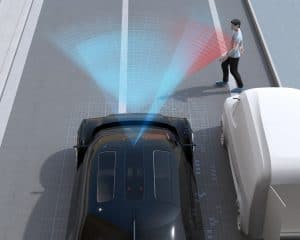Can Advanced Safety Systems Really Reduce Risks of Crash Injury?
 There are so many hazards that can affect our driving these days that you feel almost like a failure for not having 360 degree peripheral vision at all times. At times even backing out of a parking space can feel like a game of chance no matter how many times you’ve looked around beforehand. Suddenly there’s a car whizzing behind you or an oblivious person chatting on a cell phone walking into your vehicle’s path.
There are so many hazards that can affect our driving these days that you feel almost like a failure for not having 360 degree peripheral vision at all times. At times even backing out of a parking space can feel like a game of chance no matter how many times you’ve looked around beforehand. Suddenly there’s a car whizzing behind you or an oblivious person chatting on a cell phone walking into your vehicle’s path.
Wouldn’t it be nice if you owned an automobile that could predict all of these obstacles and react to keep you safe? The technology is here and is being shown to reduce auto accidents enough to warrant the price increase on newer automobiles. Regardless, any level of autonomous vehicle still requires an attentive operator to be sitting behind the wheel to ensure mishaps are corrected quickly before someone gets hurt.
Which safety feature is most likely to prevent a crash?
Advanced Driver-Assistance Systems (ADAS) are becoming commonplace on new vehicles. Whether you like it or not, vehicles are beginning to come with an increasing amount of artificial intelligence to guide your driving with or without your assistance. As it currently stands, these systems have reduced bodily injury claims by 27% and property damage claims by 19%. Those are some pretty significant safety statistics.
These systems include features such as:
- Adaptive cruise control
- Automatic emergency braking
- Blind spot detection
- Collision warning
- Cross-traffic alert
- Forward and rear collision warning
- Lane departure warning
- Pedestrian detection system
- Road sign recognition
ADAS is designed by installing sensors and cameras around the vehicle to prevent all types of accidents from occurring. While this may help keep you safe, don’t expect car insurance rates to go down. The added cost of these systems, while worth saving lives, makes vehicle damage claims more costly.
What are the most dangerous types of collisions?
There are numerous types of collisions ranging from those causing negligible damage to accidents resulting in wrongful death. Some of the worst collisions drivers may now be able to avoid using ADAS include:
- Head-on collisions
This type of car accident is at the top of the list for being the deadliest, when you consider that both vehicles are in motion and come to a sudden violent stop on impact due to each colliding with a solid object. These crashes tend to cause catastrophic injuries and death.
Collision warning, cross-traffic alert, and forward collision warning, and road sign recognition may all be helpful in warning drivers of an impending head-on collision or how to avoid one, particularly at night when it can be harder to see.
- Roadway departures
A distracted driver could veer into your lane, or an object could be sitting in your path, but nighttime driving prevented you from seeing it until it was too late. Whatever the reason that caused you to lose control and spin into the median or land off the shoulder, your vehicle could roll, or you could be forced into another object.
Collision warning, cross-traffic alert, forward and rear collision warning, and lane departure warning may all come in handy to notify drivers that they need to correct or adjust their course to avoid leaving the road and crashing.
- Single car crashes
Whether you reverse into a telephone pole while backing out of a driveway or you slam into a concrete light post on a highway, you can suffer injuries without assistance from a second vehicle.
Collision warning and automatic emergency braking can detect objects to avoid forward collisions, lane departure warning can alert you that you need to move back into your lane to avoid crashing your vehicle, and road sign recognition can notify you of dangers ahead such as sharp curves that require reduced speed to navigate safely.
If you have a teenage driver, pay close attention
According to the Insurance Institute for Highway Safety (IIHS), teenagers are among those most likely to die in a car crash. You may ask why that is given that these advanced safety systems are shown to reduce accidents. The answer is simple. Teens are, more often than not, driving smaller cars that predate all of these life-saving features found on newer vehicles. They’re more economical for young drivers who just want a taste of freedom and don’t have a lot of spare cash to buy a newer vehicle.
If you have one of these drivers in your home and cannot afford to help them buy a newer vehicle, consider spending the money to add some of this technology to their older car. Forward collision warning systems and backup cameras can be purchased separately and installed.
Safety is the primary goal for responsible drivers. You just want to get where you need to go and get back home in one piece. Even if you choose to go out for a drive to relax, you want to know that you’re not taking unnecessary risks. Even with all of the advanced technology available, accidents still happen. If you or a loved one has been injured by a negligent driver, the Savannah and Atlanta car accident injury lawyers at Harris Lowry Manton LLP will fight to protect your family’s wellbeing by filing claim to compensate you for your loss.
Schedule your free case evaluation with an experienced member of our legal team by calling our Atlanta office at 404-998-8847, our Savannah office at 912-417-3774, or by reaching out to us through our contact page to tell us your story.

Jed Manton is committed to representing individuals and business that have been harmed by the actions of others. With a solid track record, Jed has helped numerous clients who have been seriously injured or who have lost a loved one obtain justice, while holding the wrongdoer accountable.
Read more about Jed D. Manton here.
